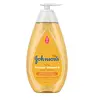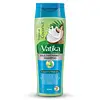What's inside
What's inside
 Key Ingredients
Key Ingredients

No key ingredients
 Benefits
Benefits

 Concerns
Concerns

 Ingredients Side-by-side
Ingredients Side-by-side

Water
Skin ConditioningSodium Laureth Sulfate
CleansingDimethiconol
EmollientCocamide Mea
EmulsifyingCocamidopropyl Betaine
CleansingGlycol Distearate
EmollientParfum
MaskingSodium Chloride
MaskingAmodimethicone
Sodium PCA
HumectantCarbomer
Emulsion StabilisingGuar Hydroxypropyltrimonium Chloride
Skin ConditioningLawsonia Inermis Leaf Extract
Skin ConditioningPanthenol
Skin ConditioningSodium Hydroxide
BufferingDisodium EDTA
Hydrolyzed Vegetable Protein
Skin ConditioningIsopropyl Laurate
EmollientIsopropyl Myristate
EmollientIsopropyl Palmitate
EmollientIsopropyl Stearate
EmollientIsopropyl Oleate
EmollientRicinus Communis Seed Oil
MaskingGlycine Soja Oil
EmollientCarthamus Tinctorius Seed Oil
MaskingLinoleic Acid
CleansingRetinyl Palmitate
Skin ConditioningTocopheryl Acetate
AntioxidantPEG-90m
Emulsion StabilisingLactic Acid
BufferingTea-Dodecylbenzenesulfonate
CleansingTrideceth-12
EmulsifyingCetrimonium Chloride
AntimicrobialPropylene Glycol
HumectantPhenoxyethanol
PreservativeMethylparaben
PreservativeEthylparaben
PreservativePropylparaben
PreservativeButylparaben
MaskingMagnesium Nitrate
Magnesium Chloride
Methylchloroisothiazolinone
PreservativeMethylisothiazolinone
PreservativeAmyl Cinnamal
PerfumingLimonene
PerfumingLinalool
PerfumingWater, Sodium Laureth Sulfate, Dimethiconol, Cocamide Mea, Cocamidopropyl Betaine, Glycol Distearate, Parfum, Sodium Chloride, Amodimethicone, Sodium PCA, Carbomer, Guar Hydroxypropyltrimonium Chloride, Lawsonia Inermis Leaf Extract, Panthenol, Sodium Hydroxide, Disodium EDTA, Hydrolyzed Vegetable Protein, Isopropyl Laurate, Isopropyl Myristate, Isopropyl Palmitate, Isopropyl Stearate, Isopropyl Oleate, Ricinus Communis Seed Oil, Glycine Soja Oil, Carthamus Tinctorius Seed Oil, Linoleic Acid, Retinyl Palmitate, Tocopheryl Acetate, PEG-90m, Lactic Acid, Tea-Dodecylbenzenesulfonate, Trideceth-12, Cetrimonium Chloride, Propylene Glycol, Phenoxyethanol, Methylparaben, Ethylparaben, Propylparaben, Butylparaben, Magnesium Nitrate, Magnesium Chloride, Methylchloroisothiazolinone, Methylisothiazolinone, Amyl Cinnamal, Limonene, Linalool
 Reviews
Reviews

Ingredients Explained
These ingredients are found in both products.
Ingredients higher up in an ingredient list are typically present in a larger amount.
Cocamidopropyl Betaine is a fatty acid created by mixing similar compounds in coconut oil and dimethylaminopropylamine, a compound with two amino groups.
This ingredient is a surfactant and cleanser. It helps gather the dirt, pollutants, and other impurities in your skin to be washed away. It also helps thicken a product and make the texture more creamy.
Being created from coconut oil means Cocamidopropyl Betaine is hydrating for the skin.
While Cocamidopropyl Betaine was believed to be an allergen, a study from 2012 disproved this. It found two compounds in unpure Cocamidopropyl Betaine to be the irritants: aminoamide and 3-dimethylaminopropylamine. High-grade and pure Cocamidopropyl Betaine did not induce allergic reactions during this study.
Learn more about Cocamidopropyl BetaineDisodium EDTA plays a role in making products more stable by aiding other preservatives.
It is a chelating agent, meaning it neutralizes metal ions that may be found in a product.
Disodium EDTA is a salt of edetic acid and is found to be safe in cosmetic ingredients.
Learn more about Disodium EDTAParfum is a catch-all term for an ingredient or more that is used to give a scent to products.
Also called "fragrance", this ingredient can be a blend of hundreds of chemicals or plant oils. This means every product with "fragrance" or "parfum" in the ingredients list is a different mixture.
For instance, Habanolide is a proprietary trade name for a specific aroma chemical. When used as a fragrance ingredient in cosmetics, most aroma chemicals fall under the broad labeling category of “FRAGRANCE” or “PARFUM” according to EU and US regulations.
The term 'parfum' or 'fragrance' is not regulated in many countries. In many cases, it is up to the brand to define this term.
For instance, many brands choose to label themselves as "fragrance-free" because they are not using synthetic fragrances. However, their products may still contain ingredients such as essential oils that are considered a fragrance by INCI standards.
One example is Calendula flower extract. Calendula is an essential oil that still imparts a scent or 'fragrance'.
Depending on the blend, the ingredients in the mixture can cause allergies and sensitivities on the skin. Some ingredients that are known EU allergens include linalool and citronellol.
Parfum can also be used to mask or cover an unpleasant scent.
The bottom line is: not all fragrances/parfum/ingredients are created equally. If you are worried about fragrances, we recommend taking a closer look at an ingredient. And of course, we always recommend speaking with a professional.
Learn more about ParfumWater. It's the most common cosmetic ingredient of all. You'll usually see it at the top of ingredient lists, meaning that it makes up the largest part of the product.
So why is it so popular? Water most often acts as a solvent - this means that it helps dissolve other ingredients into the formulation.
You'll also recognize water as that liquid we all need to stay alive. If you see this, drink a glass of water. Stay hydrated!
Learn more about Water